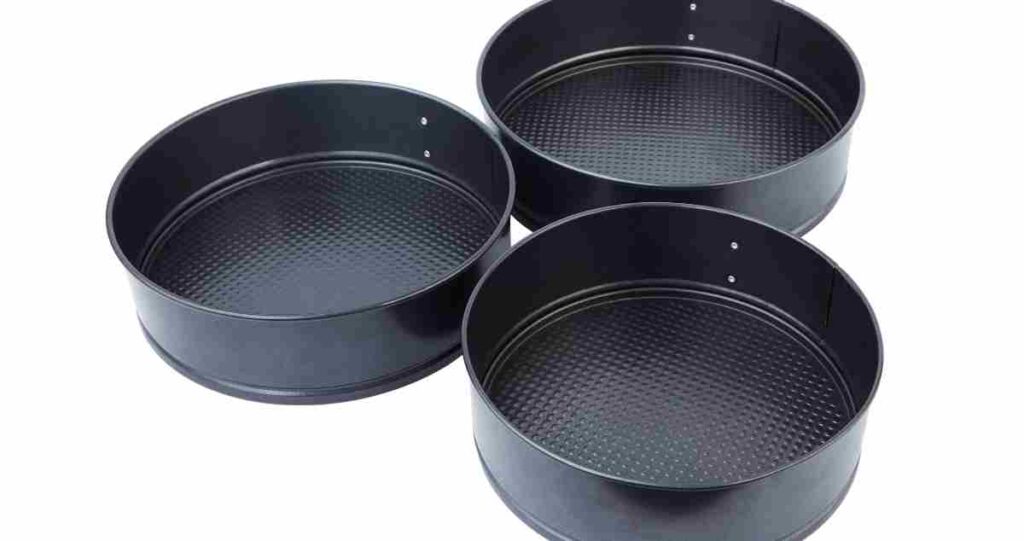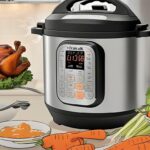Have you ever felt frustrated when encountering a tantalizing Bundt cake recipe, only to remember you don’t own a Bundt pan? You’re not alone.
The distinctive ring-shaped pan, named after the German word “Bund,” which means “community” or “gather together,” has a storied history in American baking. Its unique design allows for even baking and a delightful cake shape that turns heads at any gathering.
But here’s the secret: achieving similar results without the exact pan is possible. This blog post will lift the lid on substituting Bundt pans, ensuring that no tantalizing recipe remains out of your reach just because of the lack of a specific pan. Ready to navigate the baking world like a pro? Let’s dive right in.
What is a Bundt Pan?
When embarking on your Bundt cake-baking journey, it’s essential to understand what sets a Bundt pan apart from others and why it’s critical for certain recipes. A Bundt pan is distinguishable by its unique ring shape, a design that originated from the traditional European “kugelhopf” mold.
However, it’s not just a matter of aesthetics – this design serves a specific purpose in baking.
With its fluted, grooved sides and central tube, a Bundt pan increases the surface area exposed to the oven’s heat. This means your batter gets more evenly cooked than a traditional pan. It also allows for a lovely golden crust on the outside while the inside stays moist and tender.
The central tube or “chimney” also helps distribute heat in the middle of the cake, effectively baking it from the inside and outside. This makes a Bundt pan ideal for dense, moist cakes that could otherwise end up being undercooked in the center.
The size of a Bundt pan can also vary, but a standard Bundt pan typically holds 12 cups of batter, which is significantly more than most standard cake pans. This size difference is another aspect to keep in mind when considering substitutions.
Top 3 Substitutions for Bundt Pan:
1. Round Cake Pan:
Suppose you find yourself sans Bundt pan but armed with a dream of a beautifully baked cake; fear not. One of the easiest and most accessible Bundt pan substitutes can be found in your standard round cake pan paired with a small, oven-safe bowl or cup. Here’s how it works.
- Step 1: Take a standard round cake pan, ideally 9 or 10 inches in diameter, and a small oven-safe bowl or ramekin that can fit in the center of the pan. The bowl will create a hole in the middle, mimicking the unique design of a Bundt pan.
- Step 2: Grease both the cake pan and the small bowl generously. The bowl must be as non-stick as the pan to ensure the cake’s smooth removal after baking.
- Step 3: Place the bowl in the center of the pan and carefully pour your batter into the pan, making sure to distribute it evenly around the bowl. Be careful not to overfill the pan. Remember, Bundt pans typically have a larger capacity than standard pans.
When using this method, remember that a round cake pan might heat and bake differently than a Bundt pan due to its different shape and material. You’ll likely need to adjust your baking time or temperature to achieve the desired result. Check the cake for doneness earlier than the recipe’s suggested time to prevent overbaking.
2. Substitution 2: Springform Pan
Our second method involves an item that may be lurking in your kitchen – a springform pan. Known for its removable sides, the springform pan is a favorite for bakers with delicate pastries or elaborate desserts like cheesecakes. But it can also come to the rescue when you miss a Bundt pan.
Here’s how to utilize a springform pan as a Bundt pan substitute:
- Step 1: Start with your standard nine or 10-inch springform pan. For the “tube” in the middle, find a heatproof ramekin or small bowl that can fit comfortably in the center of the pan.
- Step 2: Prepare your pan and bowl by applying a generous butter or non-stick spray coating. This step is crucial for ensuring your cake comes out cleanly after baking.
- Step 3: Place the small bowl in the center of the pan and pour the batter around it, ensuring the distribution is even. Be cautious not to overfill the pan – remember, your springform pan may not be as deep as a traditional Bundt pan.
Thanks to its removable sides, the springform pan method is a handy solution when dealing with thick batters. It’s also worth noting that a springform pan can yield a slightly larger central hole than a standard round pan, making it a closer match to a true Bundt cake’s appearance.
3. Aluminum Foil and a Regular Pan:
When there’s a will (and a roll of aluminum foil), there’s a way! Our third Bundt pan substitution strategy gets crafty, using a bit of DIY spirit to transform a regular pan into a Bundt pan facsimile. This option is particularly handy if you’re short on kitchenware or in a pinch with limited resources.
- Step 1: Start with a standard round or square cake pan. Next, grab a sturdy roll of aluminum foil.
- Step 2: Fold a long foil strip into a thick, circular rope-like shape. The size of your “rope” will determine the diameter of your cake’s center hole, so aim for a size similar to a traditional Bundt pan.
- Step 3: Position your aluminum foil circle in the center of the cake pan. It should be sturdy enough to hold its shape when adding the batter. If it’s not stable, consider doubling the foil.
- Step 4: Generously grease your pan and aluminum foil to ensure a smooth release after baking. Pour in the batter, ensuring it’s evenly distributed around the foil circle.
While this DIY method offers a quick solution to your Bundt pan dilemma, there are a few potential drawbacks to remember. For one, the aluminum foil won’t conduct heat in the same way the central tube of a Bundt pan would, which might impact baking time and the evenness of baking.
Other Options for Bundt Pan Substitutions:
While the three methods we’ve explored so far are among the most common and accessible Bundt pan substitutes, the world of baking is as broad as it is deep, and there are a few other options you might consider. Here’s a quick overview of less common but potential alternatives:
- Tube Pan: A tube pan is the closest relative to a Bundt pan and can often be used interchangeably. Often used for angel food cakes, tube pans also have a central tube and allow for even baking. However, they lack the decorative sides of a Bundt pan and are often larger, so you may need to adjust your batter volume or baking time.
- Loaf Pan: A loaf pan won’t give you the classic round shape of a Bundt cake, but it can work in a pinch, especially for denser cakes. You may need to use multiple loaf pans depending on the volume of your batter, and the baking time will likely need to be adjusted.
- Muffin Tin or Cupcake Pan: If you’re up for a twist on a classic Bundt cake, consider making mini Bundts using a muffin tin. These adorable, individual-sized cakes will bake faster and can be a fun variation for parties or family dinners.
 Conclusion:
Conclusion:
And there you have it! We’ve journeyed through the land of Bundt pan substitutions, unveiling that a lack of the specific tool doesn’t have to derail your baking plans.
Whether you opt for a standard round pan, a springform pan, or get crafty with aluminum foil, remember that the essence of baking lies in the precision and the joy of improvisation and adaptation.
The next time you come across a Bundt cake recipe, don’t let the absence of a Bundt pan stop you. Instead, embrace one of these alternative methods and prepare to surprise yourself—and your guests—with a delicious and beautifully baked cake that defies convention.
- What size pan is one and a half (1.5) quarts? - June 8, 2023
- Le Creuset saucepan sizes: Choosing the Perfect Pan - June 8, 2023
- Blue diamond pan instructions: Step-by-Step Guide - June 8, 2023






